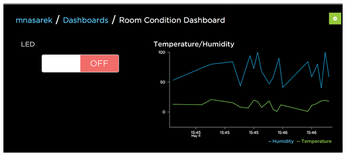IoT communication with the Adafruit IO API
Switching via the Dashboard
The program code for the Huzzah board in Listing 1 and the circuit in Figure 1 already includes a convenient function for receiving messages from the dashboard. This approach makes it easy for the developer to trigger actions on the IoT device. The LED on GPIO 13 controls an event handler that receives messages from a feed. The example shows the feed titled LED.

You create the dashboard in Figure 4 via Dashboard | Actions | Create a New Dashboard. You can then click on the blue plus symbol to add a new block to this dashboard. After selecting the toggle button and linking it with the LED feed, you create the block using Create block. The dashboard also includes a line graph next to the button for the LED that shows the temperature and humidity levels.

Finally, when you click on the toggle button on the dashboard, the sensor board detects it and turns the LED on or off. The function led-> onMessage() in Listing 1 redirects incoming notifications to the handleMsg() function, which analyzes the content of the message and switches to the appropriate LED.
Conclusions
Open hardware platforms such as Arduino and Adafruit lower the barriers for creative IoT projects. Meanwhile, the Adafruit IO API makes it particularly easy to combine network-compatible sensors with web dashboards and control them via the Internet. Only a few lines of script integrate applications into the Linux desktop.
Dashboards don't just display the measured data, they are also perfect for controlling hardware. Application output, as well as system values such as CPU and memory usage, can trigger events on the IoT hardware. You can use this triggering feature to display a message or output a signal to another hardware component, such as a light or WiFi socket.
Infos
- Arduino website: https://www.arduino.cc
- Adafruit Industries: http://www.adafruit.com
- Arduino Yún: https://www.arduino.cc/en/Main/ArduinoBoardYun
- Adafruit IO API website http://io.adafruit.com
- Adafruit IO REST API documentation: http://io.adafruit.com/api/docs
- Adafruit IO Node.js server: https://github.com/adafruit/adafruit-io-node
- Adafruit Huzzah: https://www.adafruit.com.product/2471
- The Arduino development environment: https://www.arduino.cc/en/Main/software
- Adafruit Huzzah integrates into the Arduino IDE: https://learn.adafruit.com/adafruit-huzzah-esp8266-breakout/using-arduino-ide
- Argos plugin: https://github.com/p-e-w/argos
- KDE Plasma widget development: https://techbase.kde.org/Development/Tutorials/Plasma5/QML2/GettingStarted
- Conky desktop widget: https://github.com/brndmtthws/conky
- Simple Conky: http://custom-linux.deviantart.com/art/Simple-Conky-454759768
- Ostrich Sans font: https://github.com/theleagueof/ostrich-sans
« Previous 1 2
Buy this article as PDF
(incl. VAT)
Buy Linux Magazine
Subscribe to our Linux Newsletters
Find Linux and Open Source Jobs
Subscribe to our ADMIN Newsletters
Support Our Work
Linux Magazine content is made possible with support from readers like you. Please consider contributing when you’ve found an article to be beneficial.

News
-
XZ Gets the All-Clear
The back door xz vulnerability has been officially reverted for Fedora 40 and versions 38 and 39 were never affected.
-
Canonical Collaborates with Qualcomm on New Venture
This new joint effort is geared toward bringing Ubuntu and Ubuntu Core to Qualcomm-powered devices.
-
Kodi 21.0 Open-Source Entertainment Hub Released
After a year of development, the award-winning Kodi cross-platform, media center software is now available with many new additions and improvements.
-
Linux Usage Increases in Two Key Areas
If market share is your thing, you'll be happy to know that Linux is on the rise in two areas that, if they keep climbing, could have serious meaning for Linux's future.
-
Vulnerability Discovered in xz Libraries
An urgent alert for Fedora 40 has been posted and users should pay attention.
-
Canonical Bumps LTS Support to 12 years
If you're worried that your Ubuntu LTS release won't be supported long enough to last, Canonical has a surprise for you in the form of 12 years of security coverage.
-
Fedora 40 Beta Released Soon
With the official release of Fedora 40 coming in April, it's almost time to download the beta and see what's new.
-
New Pentesting Distribution to Compete with Kali Linux
SnoopGod is now available for your testing needs
-
Juno Computers Launches Another Linux Laptop
If you're looking for a powerhouse laptop that runs Ubuntu, the Juno Computers Neptune 17 v6 should be on your radar.
-
ZorinOS 17.1 Released, Includes Improved Windows App Support
If you need or desire to run Windows applications on Linux, there's one distribution intent on making that easier for you and its new release further improves that feature.

